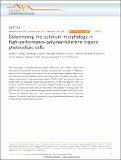Files in this item
Determining the optimum morphology in high-performance polymer-fullerene organic photovoltaic cells
Item metadata
| dc.contributor.author | Hedley, Gordon James | |
| dc.contributor.author | Ward, Alexander J | |
| dc.contributor.author | Alekseev, Alexander | |
| dc.contributor.author | Howells, Calvyn Travis | |
| dc.contributor.author | Rezende Martins, Emiliano | |
| dc.contributor.author | Serrano, Luis A | |
| dc.contributor.author | Cooke, Graeme | |
| dc.contributor.author | Ruseckas, Arvydas | |
| dc.contributor.author | Samuel, Ifor David William | |
| dc.date.accessioned | 2013-12-18T09:31:02Z | |
| dc.date.available | 2013-12-18T09:31:02Z | |
| dc.date.issued | 2013-12-17 | |
| dc.identifier | 77340721 | |
| dc.identifier | a5ef109a-9a76-497d-9eab-f8f13132d7f8 | |
| dc.identifier | 84890603612 | |
| dc.identifier.citation | Hedley , G J , Ward , A J , Alekseev , A , Howells , C T , Rezende Martins , E , Serrano , L A , Cooke , G , Ruseckas , A & Samuel , I D W 2013 , ' Determining the optimum morphology in high-performance polymer-fullerene organic photovoltaic cells ' , Nature Communications , vol. 4 , 2867 . https://doi.org/10.1038/ncomms3867 | en |
| dc.identifier.issn | 2041-1723 | |
| dc.identifier.other | ORCID: /0000-0001-9114-3522/work/32543066 | |
| dc.identifier.uri | https://hdl.handle.net/10023/4302 | |
| dc.description | This work was supported by the Engineering and Physical Sciences Research Council (grant number EP/I013288/1) and from the European Union Seventh Framework Programme under grant agreement 321305. | en |
| dc.description.abstract | The morphology of bulk heterojunction organic photovoltaic cells defines many of the device performance characteristics. Measuring the morphology is challenging due to the small length scales and low contrast between organic materials. Here we have utilised nanoscale photocurrent mapping, ultrafast fluorescence and exciton diffusion to observe the detailed morphology of a high performance blend. We show that optimised blends consist of elongated fullerene-rich and polymer-rich fibre-like domains which are 10-50 nm wide and 200-400 nm long. These elongated domains provide a concentration gradient for directional charge diffusion which helps extraction of charge pairs with 80% efficiency. In contrast, blends with agglomerated fullerene spheres show a much lower efficiency of charge extraction of ~45% which is attributed to poor electron and hole transport. Our results show that formation of narrow and elongated domains are desirable in bulk heterojunction solar cells. | |
| dc.format.extent | 10 | |
| dc.format.extent | 1934355 | |
| dc.language.iso | eng | |
| dc.relation.ispartof | Nature Communications | en |
| dc.subject | QC Physics | en |
| dc.subject | SDG 7 - Affordable and Clean Energy | en |
| dc.subject.lcc | QC | en |
| dc.title | Determining the optimum morphology in high-performance polymer-fullerene organic photovoltaic cells | en |
| dc.type | Journal article | en |
| dc.contributor.sponsor | EPSRC | en |
| dc.contributor.sponsor | European Research Council | en |
| dc.contributor.institution | University of St Andrews. School of Physics and Astronomy | en |
| dc.contributor.institution | University of St Andrews. Condensed Matter Physics | en |
| dc.identifier.doi | https://doi.org/10.1038/ncomms3867 | |
| dc.description.status | Peer reviewed | en |
| dc.identifier.grantnumber | EP/I013288/1 | en |
| dc.identifier.grantnumber | en |
This item appears in the following Collection(s)
Items in the St Andrews Research Repository are protected by copyright, with all rights reserved, unless otherwise indicated.

